七年级上英语|七Unit 2 Is this your pencil?|教案
文档属性
| 名称 | 七年级上英语|七Unit 2 Is this your pencil?|教案 |
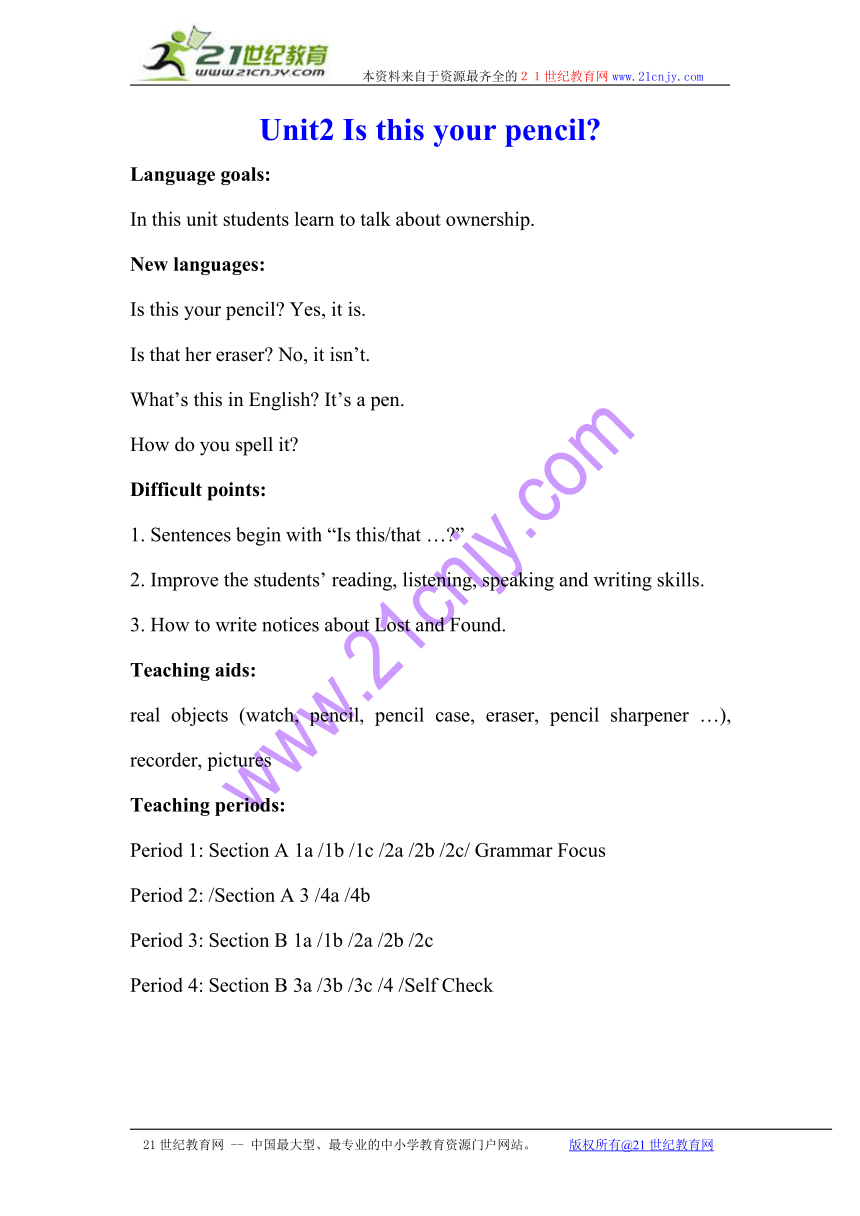
|
|
| 格式 | rar | ||
| 文件大小 | 18.9KB | ||
| 资源类型 | 教案 | ||
| 版本资源 | 人教新目标(Go for it)版 | ||
| 科目 | 英语 | ||
| 更新时间 | 2010-12-24 10:26:00 | ||
图片预览

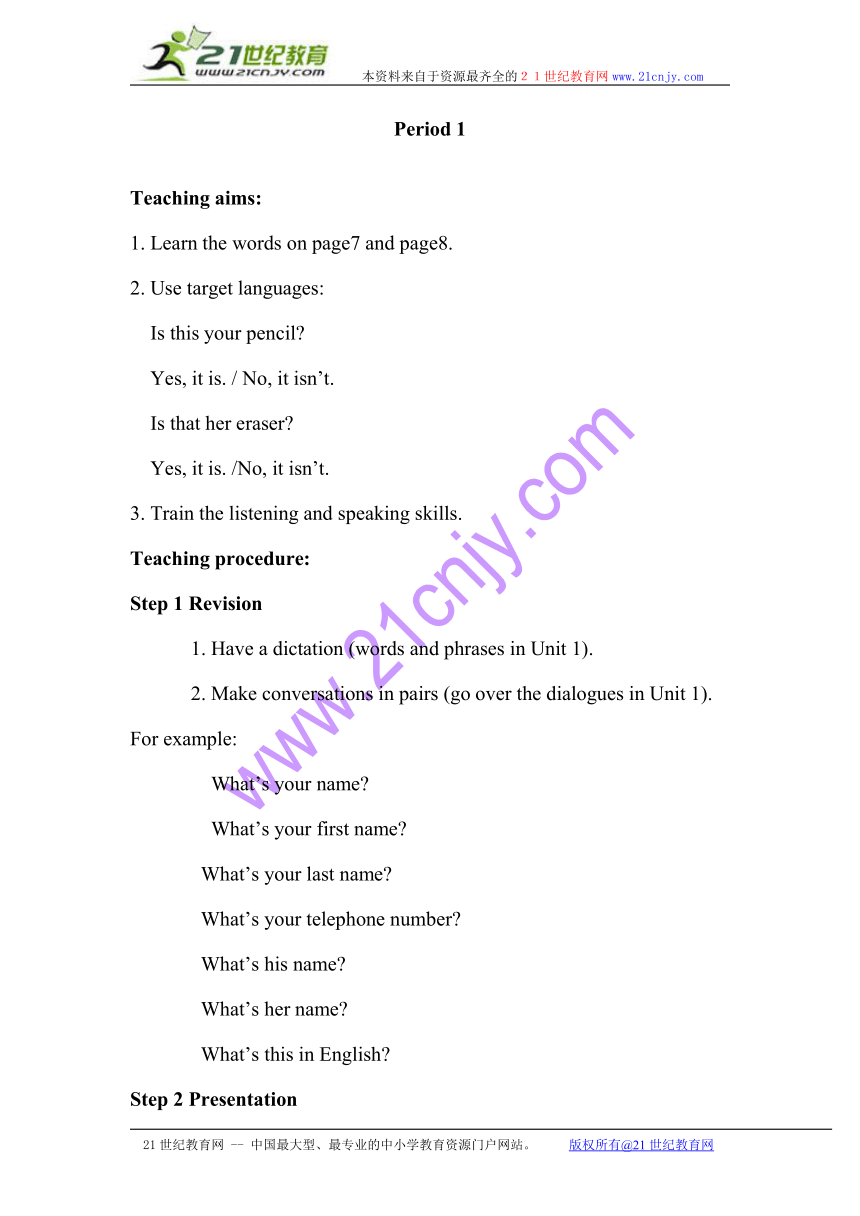
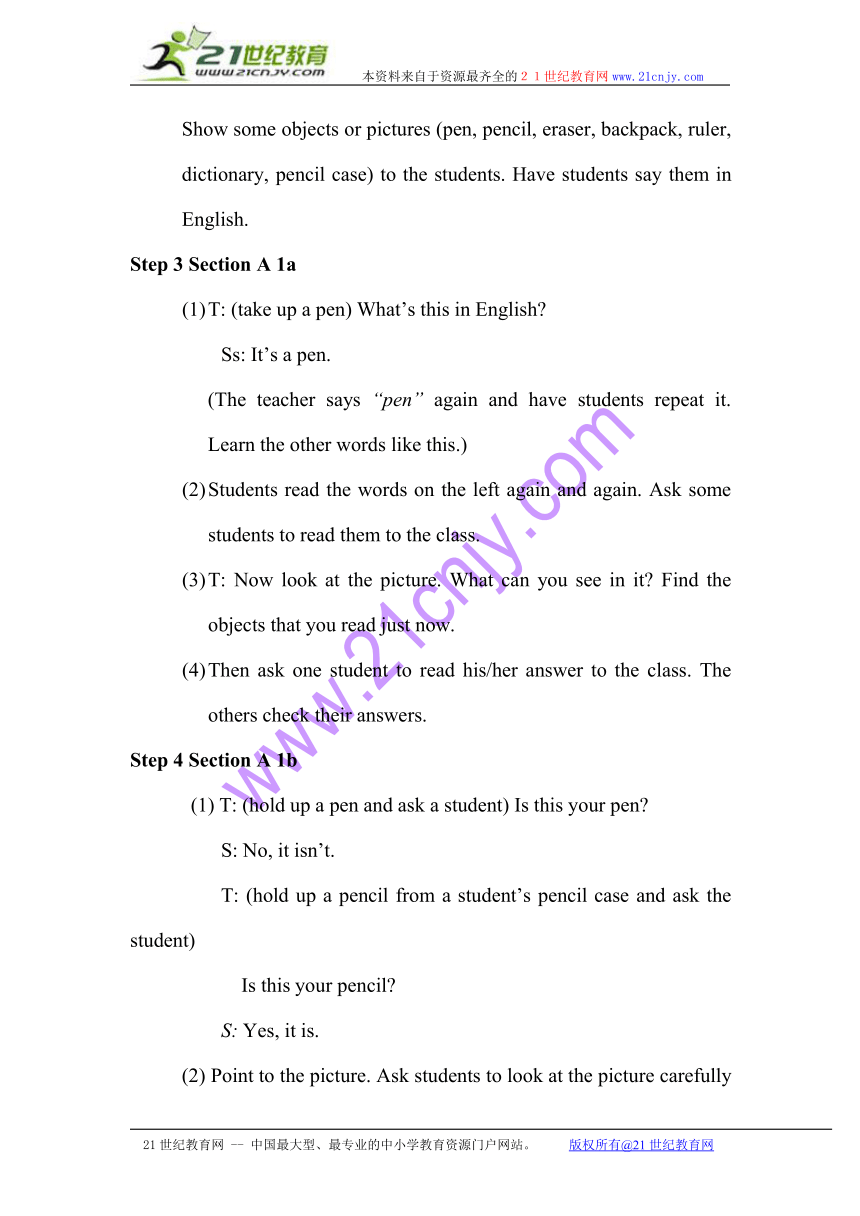
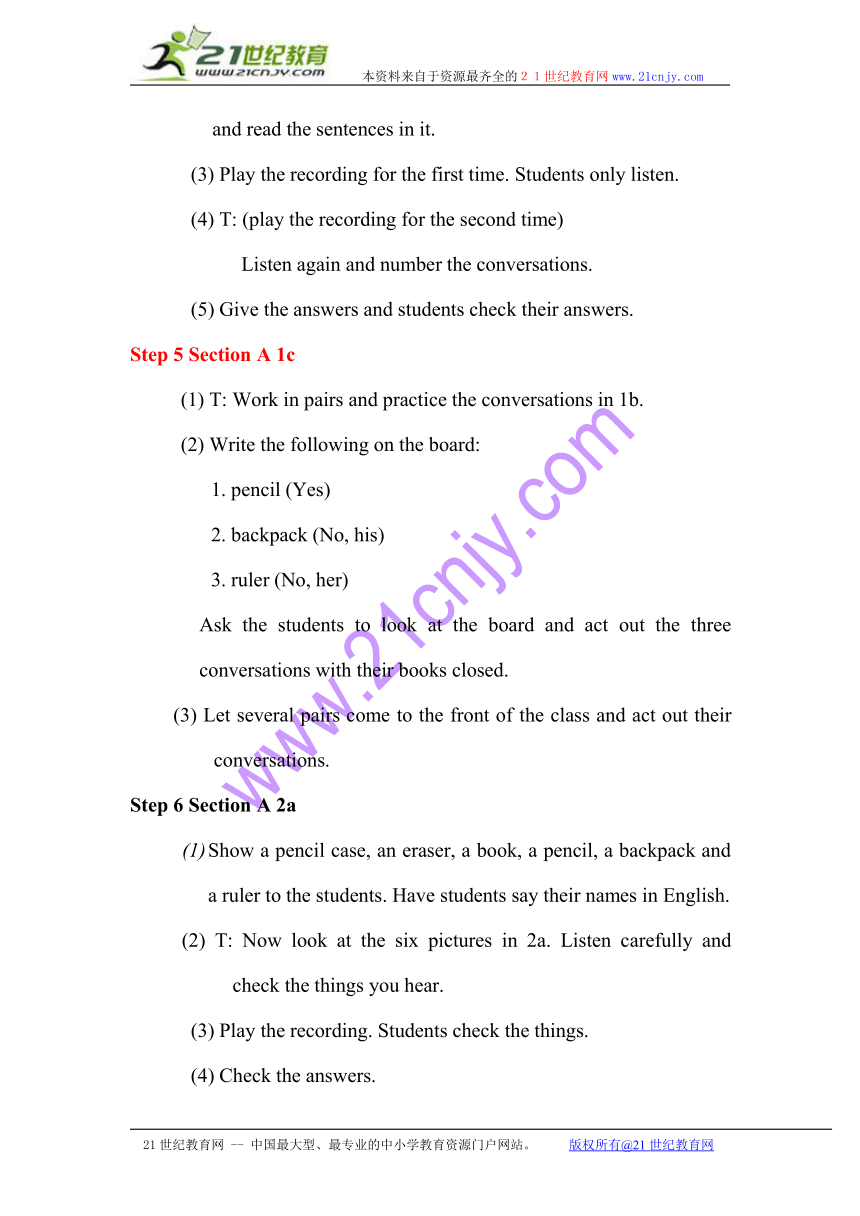
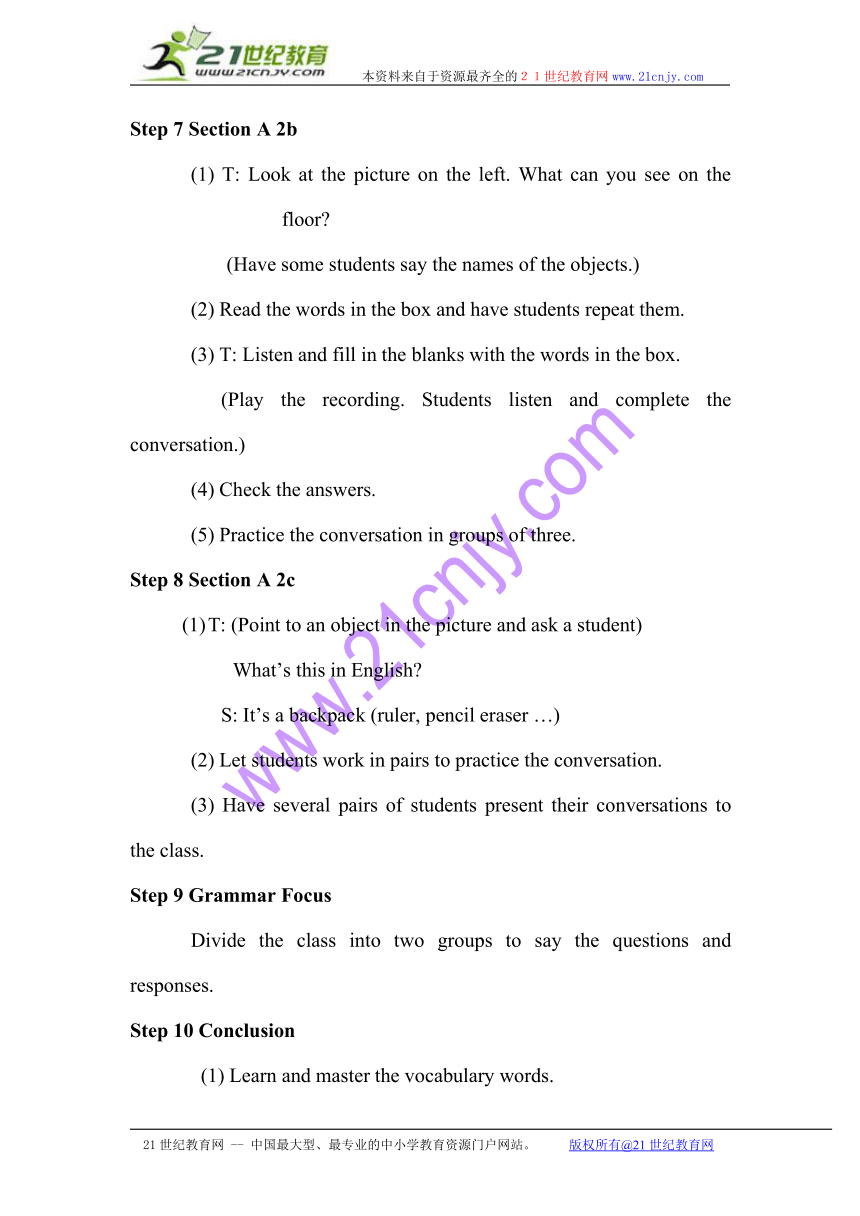
文档简介
本资料来自于资源最齐全的21世纪教育网www.21cnjy.com
Unit2 Is this your pencil
Language goals:
In this unit students learn to talk about ownership.
New languages:
Is this your pencil Yes, it is.
Is that her eraser No, it isn’t.
What’s this in English It’s a pen.
How do you spell it
Difficult points:
1. Sentences begin with “Is this/that … ”
2. Improve the students’ reading, listening, speaking and writing skills.
3. How to write notices about Lost and Found.
Teaching aids:
real objects (watch, pencil, pencil case, eraser, pencil sharpener …), recorder, pictures
Teaching periods:
Period 1: Section A 1a /1b /1c /2a /2b /2c/ Grammar Focus
Period 2: /Section A 3 /4a /4b
Period 3: Section B 1a /1b /2a /2b /2c
Period 4: Section B 3a /3b /3c /4 /Self Check
Period 1
Teaching aims:
1. Learn the words on page7 and page8.
2. Use target languages:
Is this your pencil
Yes, it is. / No, it isn’t.
Is that her eraser
Yes, it is. /No, it isn’t.
3. Train the listening and speaking skills.
Teaching procedure:
Step 1 Revision
1. Have a dictation (words and phrases in Unit 1).
2. Make conversations in pairs (go over the dialogues in Unit 1). For example:
What’s your name
What’s your first name
What’s your last name
What’s your telephone number
What’s his name
What’s her name
What’s this in English
Step 2 Presentation
Show some objects or pictures (pen, pencil, eraser, backpack, ruler, dictionary, pencil case) to the students. Have students say them in English.
Step 3 Section A 1a
(1) T: (take up a pen) What’s this in English
Ss: It’s a pen.
(The teacher says “pen” again and have students repeat it. Learn the other words like this.)
(2) Students read the words on the left again and again. Ask some students to read them to the class.
(3) T: Now look at the picture. What can you see in it Find the objects that you read just now.
(4) Then ask one student to read his/her answer to the class. The others check their answers.
Step 4 Section A 1b
(1) T: (hold up a pen and ask a student) Is this your pen
S: No, it isn’t.
T: (hold up a pencil from a student’s pencil case and ask the student)
Is this your pencil
S: Yes, it is.
(2) Point to the picture. Ask students to look at the picture carefully and read the sentences in it.
(3) Play the recording for the first time. Students only listen.
(4) T: (play the recording for the second time)
Listen again and number the conversations.
(5) Give the answers and students check their answers.
Step 5 Section A 1c
(1) T: Work in pairs and practice the conversations in 1b.
(2) Write the following on the board:
1. pencil (Yes)
2. backpack (No, his)
3. ruler (No, her)
Ask the students to look at the board and act out the three conversations with their books closed.
(3) Let several pairs come to the front of the class and act out their conversations.
Step 6 Section A 2a
(1) Show a pencil case, an eraser, a book, a pencil, a backpack and a ruler to the students. Have students say their names in English.
(2) T: Now look at the six pictures in 2a. Listen carefully and check the things you hear.
(3) Play the recording. Students check the things.
(4) Check the answers.
Step 7 Section A 2b
(1) T: Look at the picture on the left. What can you see on the floor
(Have some students say the names of the objects.)
(2) Read the words in the box and have students repeat them.
(3) T: Listen and fill in the blanks with the words in the box.
(Play the recording. Students listen and complete the conversation.)
(4) Check the answers.
(5) Practice the conversation in groups of three.
Step 8 Section A 2c
(1) T: (Point to an object in the picture and ask a student)
What’s this in English
S: It’s a backpack (ruler, pencil eraser …)
(2) Let students work in pairs to practice the conversation.
(3) Have several pairs of students present their conversations to the class.
Step 9 Grammar Focus
Divide the class into two groups to say the questions and responses.
Step 10 Conclusion
(1) Learn and master the vocabulary words.
(2) Master the target languages.
Is this your pencil Yes, it is.
Is that her eraser No, it isn’t.
Step 11 Homework
(1) Learn the vocabulary words by heart.
(2) Practice the conversations in 2b and Grammar Focus.
(3) Do some preparing.
Period 2
Teaching aims:
1. Memorize the words and phrases: how, do, spell, baseball
2. Use the sentences “What’s this in English ” “How do you spell it ”
3. Train speaking skills.
Teaching procedure:
Step 1 Revision
(1) Go over the words in last class. Show some pictures or real objects to the students. Have them say their names and spell them.
(2) Ask students to make conversations:
Is this/that your …
Yes it is. /No, it isn’t.
Step 2 Presentation (a game)
(1) Put a pencil sharpener, a dictionary, a pen, an eraser and a ruler in a bag.
(1) T: I have some things in this bag. You often use these things in class.
Try to guess what they are.
(When one student guesses the right object, give the object to him/her.)
Step 3 Section A 3
(1) T: Look at the five pictures. Who can say the names of the objects
(2) Demonstrate the conversation with a student:
T: What’s this in English
S: It’s a pen.
T: How do you spell it
S: P-E-N.
(1) T: (write the names of the objects on the board: pencil sharpener,
dictionary, pen, eraser, ruler)
Now work in pairs and make up five conversations like this.
(1) Have five pairs present their conversations to the class.
Step 4 Section A 4a
Take out a box. Say:
Put your school things, such as pens, pencils, rulers, n erasers into the box.
Step 5 Section A 4b
(1) T: (Take out a pen from the box and ask one student) Is this your pen
S: Yes, it is. /No, it isn’t.
(1) T: Now work in pairs. Do it like this to guess the owner of one object.
You only have two guesses.
Step 6 Conclusion
(1) Learn the words and phrases in this class.
(2) Grasp the target languages:
What’s this in English
It’s a …
How do you spell it
Step 7 Homework
(1) Memorize the words.
(2) Act out the dialogues in activity 3.
(3) Prepare next lesson.
Period 3
Teaching aims:
1. Learn the vocabulary words.
2. Target languages:
What’s this
How do you spell it
3. Train the listening and speaking skills.
Teaching procedure:
Step 1 Free talk
Ask students to have conversations in pairs freely.
Step 2 Section B 1a
(1) T: Look at the picture in 1a. What things can you see Say their names.
(Ask some students to say the names of the objects.)
(2) Read the words in the box and have students repeat them.
(3) T: Can you match the words with the things in the picture
See who does the most quickly.
(4) Ask one student to say his/her answers.
Step 3 Section B 1b
(1) T: (Point to the watch in the picture and ask one student.) What’s this
S: It’s a watch.
T: How do you spell it
S: W-A-T-C-H.
(2) T: Now work in pairs and talk about the things in the picture. (Write down the names of the objects on the board when the students are talking.)
(3) Ask some pairs of students to present their conversations to the class. Encourage them to say their conversations with their books closed.
Step 4 Section B 2a
(1) Call attention to the words and phrases in 1a and ask students to read each one.
(2) T: Now let’s listen to the recording. You’ll hear some things in 1a.
Circle the things when you hear them.
(3) Play the recording, students listen and circle the things.
(4) Have some students say their answers.
Step 5 Section B 2b
(1) T: What are Kelsey and Mike looking for Now listen to the conversation
again. Then write the names of the things in the chart.
(2) Play the recording, students listen and write the words under Kelsey and Mike.
(3) Give the answers:
Kelsey: watch, ID card
Mike: pen, baseball
Step 6 Section B 2c Pairwork
(1) Read the instruction to the class. Take the first question and answer as an
example. Demonstrate it with a student.
(2) Have students work in pairs. One student in each pair looks at page 82 and the other looks at page 86. Take turns asking and answering the questions.
Step 7 Homework
(1) Remember words in this lesson.
(2) Make a conversation.
(3) Do some preparing.
Period 4
Teaching aims:
1. Memorize the words and phrases on page 11.
2. Learn to write a notice about Lost and Found.
3. Train writing skill.
Teaching procedure:
Step 1 Revision
(1) Have a dictation of the words in last class.
(2) Act out the conversation:
A: What’s this
B: It’s a …
A: How do you spell it
B: …
Step 2 Section B 3a
(1) T: Look at the notices. Read them by yourselves.
(2) Ask the students if they have any questions about the notices. If necessary, explain some difficult sentences. Teach the students how to write this kind of notice.
(3) T: Now read the notices again, and circle the words in 1a.
(4) Give the answers:
watch, computer game, notebook, ID card
Step 3 Section B 3b
(1) T: Look at the four parts in the box. They are in the wrong order, put them in the right order to make a complete message.
(2) Students do the exercise by themselves.
(3) Ask one student to read his /her answer to the class.
(4) Students practice reading the notice.
Step 4 Section B 3c
(1) Have students read the notices in 3a again.
(2) T: Did you lose or find something Now write your own notices like the
ones in 3a. Using your real name or your classmate’s name.
(3) Have several students read their passages to the class.
Step 5 Section B 4 Groupwork
(1) Demonstrate the activity with a student:
T: (Draw a sharpener on the board and ask the student.) What’s this
S: Is it a sharpener
T: Yes.
(2) Have the students work in pairs to draw pictures, then ask and guess what the pictures are.
(3) Ask some students to present their conversations to the class.
Step 6 Self Check 1 & 2
(1) T: Look at the words in the box. Do you know all the words Check the
words you know.
(2) T: If you don’t know the meanings of some words, look them up in your
book or ask your classmates for help.
(3) Have students write five new words in their Vocab-Builder.
Step 7 Self Check 3
(1) T: Look at the picture on the left. Whose things are they
(2) Give an example with a student:
T: Is that your key
S: Yes, it is. /No, it isn’t.
(3) Ask students to complete the questions and answers individually.
(4) Check the answers.
Step 8 Homework
1. Memorize the words in Unit 2.
2. Write a notice about Lost and Found.
21世纪教育网 -- 中国最大型、最专业的中小学教育资源门户网站。 版权所有@21世纪教育网
Unit2 Is this your pencil
Language goals:
In this unit students learn to talk about ownership.
New languages:
Is this your pencil Yes, it is.
Is that her eraser No, it isn’t.
What’s this in English It’s a pen.
How do you spell it
Difficult points:
1. Sentences begin with “Is this/that … ”
2. Improve the students’ reading, listening, speaking and writing skills.
3. How to write notices about Lost and Found.
Teaching aids:
real objects (watch, pencil, pencil case, eraser, pencil sharpener …), recorder, pictures
Teaching periods:
Period 1: Section A 1a /1b /1c /2a /2b /2c/ Grammar Focus
Period 2: /Section A 3 /4a /4b
Period 3: Section B 1a /1b /2a /2b /2c
Period 4: Section B 3a /3b /3c /4 /Self Check
Period 1
Teaching aims:
1. Learn the words on page7 and page8.
2. Use target languages:
Is this your pencil
Yes, it is. / No, it isn’t.
Is that her eraser
Yes, it is. /No, it isn’t.
3. Train the listening and speaking skills.
Teaching procedure:
Step 1 Revision
1. Have a dictation (words and phrases in Unit 1).
2. Make conversations in pairs (go over the dialogues in Unit 1). For example:
What’s your name
What’s your first name
What’s your last name
What’s your telephone number
What’s his name
What’s her name
What’s this in English
Step 2 Presentation
Show some objects or pictures (pen, pencil, eraser, backpack, ruler, dictionary, pencil case) to the students. Have students say them in English.
Step 3 Section A 1a
(1) T: (take up a pen) What’s this in English
Ss: It’s a pen.
(The teacher says “pen” again and have students repeat it. Learn the other words like this.)
(2) Students read the words on the left again and again. Ask some students to read them to the class.
(3) T: Now look at the picture. What can you see in it Find the objects that you read just now.
(4) Then ask one student to read his/her answer to the class. The others check their answers.
Step 4 Section A 1b
(1) T: (hold up a pen and ask a student) Is this your pen
S: No, it isn’t.
T: (hold up a pencil from a student’s pencil case and ask the student)
Is this your pencil
S: Yes, it is.
(2) Point to the picture. Ask students to look at the picture carefully and read the sentences in it.
(3) Play the recording for the first time. Students only listen.
(4) T: (play the recording for the second time)
Listen again and number the conversations.
(5) Give the answers and students check their answers.
Step 5 Section A 1c
(1) T: Work in pairs and practice the conversations in 1b.
(2) Write the following on the board:
1. pencil (Yes)
2. backpack (No, his)
3. ruler (No, her)
Ask the students to look at the board and act out the three conversations with their books closed.
(3) Let several pairs come to the front of the class and act out their conversations.
Step 6 Section A 2a
(1) Show a pencil case, an eraser, a book, a pencil, a backpack and a ruler to the students. Have students say their names in English.
(2) T: Now look at the six pictures in 2a. Listen carefully and check the things you hear.
(3) Play the recording. Students check the things.
(4) Check the answers.
Step 7 Section A 2b
(1) T: Look at the picture on the left. What can you see on the floor
(Have some students say the names of the objects.)
(2) Read the words in the box and have students repeat them.
(3) T: Listen and fill in the blanks with the words in the box.
(Play the recording. Students listen and complete the conversation.)
(4) Check the answers.
(5) Practice the conversation in groups of three.
Step 8 Section A 2c
(1) T: (Point to an object in the picture and ask a student)
What’s this in English
S: It’s a backpack (ruler, pencil eraser …)
(2) Let students work in pairs to practice the conversation.
(3) Have several pairs of students present their conversations to the class.
Step 9 Grammar Focus
Divide the class into two groups to say the questions and responses.
Step 10 Conclusion
(1) Learn and master the vocabulary words.
(2) Master the target languages.
Is this your pencil Yes, it is.
Is that her eraser No, it isn’t.
Step 11 Homework
(1) Learn the vocabulary words by heart.
(2) Practice the conversations in 2b and Grammar Focus.
(3) Do some preparing.
Period 2
Teaching aims:
1. Memorize the words and phrases: how, do, spell, baseball
2. Use the sentences “What’s this in English ” “How do you spell it ”
3. Train speaking skills.
Teaching procedure:
Step 1 Revision
(1) Go over the words in last class. Show some pictures or real objects to the students. Have them say their names and spell them.
(2) Ask students to make conversations:
Is this/that your …
Yes it is. /No, it isn’t.
Step 2 Presentation (a game)
(1) Put a pencil sharpener, a dictionary, a pen, an eraser and a ruler in a bag.
(1) T: I have some things in this bag. You often use these things in class.
Try to guess what they are.
(When one student guesses the right object, give the object to him/her.)
Step 3 Section A 3
(1) T: Look at the five pictures. Who can say the names of the objects
(2) Demonstrate the conversation with a student:
T: What’s this in English
S: It’s a pen.
T: How do you spell it
S: P-E-N.
(1) T: (write the names of the objects on the board: pencil sharpener,
dictionary, pen, eraser, ruler)
Now work in pairs and make up five conversations like this.
(1) Have five pairs present their conversations to the class.
Step 4 Section A 4a
Take out a box. Say:
Put your school things, such as pens, pencils, rulers, n erasers into the box.
Step 5 Section A 4b
(1) T: (Take out a pen from the box and ask one student) Is this your pen
S: Yes, it is. /No, it isn’t.
(1) T: Now work in pairs. Do it like this to guess the owner of one object.
You only have two guesses.
Step 6 Conclusion
(1) Learn the words and phrases in this class.
(2) Grasp the target languages:
What’s this in English
It’s a …
How do you spell it
Step 7 Homework
(1) Memorize the words.
(2) Act out the dialogues in activity 3.
(3) Prepare next lesson.
Period 3
Teaching aims:
1. Learn the vocabulary words.
2. Target languages:
What’s this
How do you spell it
3. Train the listening and speaking skills.
Teaching procedure:
Step 1 Free talk
Ask students to have conversations in pairs freely.
Step 2 Section B 1a
(1) T: Look at the picture in 1a. What things can you see Say their names.
(Ask some students to say the names of the objects.)
(2) Read the words in the box and have students repeat them.
(3) T: Can you match the words with the things in the picture
See who does the most quickly.
(4) Ask one student to say his/her answers.
Step 3 Section B 1b
(1) T: (Point to the watch in the picture and ask one student.) What’s this
S: It’s a watch.
T: How do you spell it
S: W-A-T-C-H.
(2) T: Now work in pairs and talk about the things in the picture. (Write down the names of the objects on the board when the students are talking.)
(3) Ask some pairs of students to present their conversations to the class. Encourage them to say their conversations with their books closed.
Step 4 Section B 2a
(1) Call attention to the words and phrases in 1a and ask students to read each one.
(2) T: Now let’s listen to the recording. You’ll hear some things in 1a.
Circle the things when you hear them.
(3) Play the recording, students listen and circle the things.
(4) Have some students say their answers.
Step 5 Section B 2b
(1) T: What are Kelsey and Mike looking for Now listen to the conversation
again. Then write the names of the things in the chart.
(2) Play the recording, students listen and write the words under Kelsey and Mike.
(3) Give the answers:
Kelsey: watch, ID card
Mike: pen, baseball
Step 6 Section B 2c Pairwork
(1) Read the instruction to the class. Take the first question and answer as an
example. Demonstrate it with a student.
(2) Have students work in pairs. One student in each pair looks at page 82 and the other looks at page 86. Take turns asking and answering the questions.
Step 7 Homework
(1) Remember words in this lesson.
(2) Make a conversation.
(3) Do some preparing.
Period 4
Teaching aims:
1. Memorize the words and phrases on page 11.
2. Learn to write a notice about Lost and Found.
3. Train writing skill.
Teaching procedure:
Step 1 Revision
(1) Have a dictation of the words in last class.
(2) Act out the conversation:
A: What’s this
B: It’s a …
A: How do you spell it
B: …
Step 2 Section B 3a
(1) T: Look at the notices. Read them by yourselves.
(2) Ask the students if they have any questions about the notices. If necessary, explain some difficult sentences. Teach the students how to write this kind of notice.
(3) T: Now read the notices again, and circle the words in 1a.
(4) Give the answers:
watch, computer game, notebook, ID card
Step 3 Section B 3b
(1) T: Look at the four parts in the box. They are in the wrong order, put them in the right order to make a complete message.
(2) Students do the exercise by themselves.
(3) Ask one student to read his /her answer to the class.
(4) Students practice reading the notice.
Step 4 Section B 3c
(1) Have students read the notices in 3a again.
(2) T: Did you lose or find something Now write your own notices like the
ones in 3a. Using your real name or your classmate’s name.
(3) Have several students read their passages to the class.
Step 5 Section B 4 Groupwork
(1) Demonstrate the activity with a student:
T: (Draw a sharpener on the board and ask the student.) What’s this
S: Is it a sharpener
T: Yes.
(2) Have the students work in pairs to draw pictures, then ask and guess what the pictures are.
(3) Ask some students to present their conversations to the class.
Step 6 Self Check 1 & 2
(1) T: Look at the words in the box. Do you know all the words Check the
words you know.
(2) T: If you don’t know the meanings of some words, look them up in your
book or ask your classmates for help.
(3) Have students write five new words in their Vocab-Builder.
Step 7 Self Check 3
(1) T: Look at the picture on the left. Whose things are they
(2) Give an example with a student:
T: Is that your key
S: Yes, it is. /No, it isn’t.
(3) Ask students to complete the questions and answers individually.
(4) Check the answers.
Step 8 Homework
1. Memorize the words in Unit 2.
2. Write a notice about Lost and Found.
21世纪教育网 -- 中国最大型、最专业的中小学教育资源门户网站。 版权所有@21世纪教育网
同课章节目录
- starters 预备篇(2012秋审查)
- Unit 1 Good morning !
- Unit 2 What’s this in English?
- Unit 3 What color is it ?
- Unit 1 My name's Gina.
- Section A
- Section B
- Unit 2 This is my sister.
- Section A
- Section B
- Unit 3 Is this your pencil?
- Section A
- Section B
- Unit 4 Where's my schoolbag?
- Section A
- Section B
- Unit 5 Do you have a soccer ball?
- Section A
- Section B
- Unit 6 Do you like bananas?
- Section A
- Section B
- Unit 7 How much are these socks?
- Section A
- Section B
- Unit 8 When is your birthday?
- Section A
- Section B
- Unit 9 My favorite subject is science.
- Section A
- Section B
